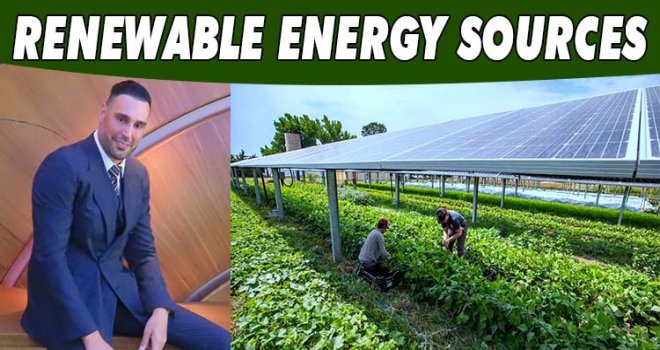RENEWABLE ENERGY SOURCES

In the context of the current ecological transition, agriculture's contribution to energy resettlement deserves emphasis. The ability to develop local resources such as biomass, usable land or the roofs of operating buildings is questioned.
Thus, agriculture expands its missions towards energy and environmental production and services. Regionalized public energy-climate action renews reflections on the links between agriculture, society, regions and local development.

However, between the recovery of local circuits and the production of raw materials for long sectors, agricultural energy sources show some uncertainty about their ability to anchor activity.
Often individual, actions also result from mobilizing local social capital in interpersonal cooperation.
Purchasing groups organize to buy milk tank coolers, heat recovery units, photovoltaic panels, sawdust boilers and solar water heaters.
Farmers can participate in these actions without disrupting their production systems. Agricultural autonomy is often a founding motivation.
Renewable energy generation by farmers is part of a more global context of concern for climate-energy issues, but also for energy sobriety and the fight against greenhouse gases.
Entrepreneurial, individual and collective dynamics take many forms. However, they prefer the renewable energy production capacity of agriculture rather than reducing consumption.
Farmers and Energy Resources
Agricultural autonomy issues and development of local resources
Concerns about direct and indirect energy consumption and greenhouse gas emissions were confirmed. Agriculture was no exception. Energy, which is seen as a weighting cost to farms, is also an opportunity to diversify incomes.
Agriculture represented 2.7% of direct final energy consumption, 70% of which was due to mechanization.
However, 60% of agricultural energy consumption is indirect and linked to the production of inputs and their transport.
However, agriculture was particularly emphasized because of its share of greenhouse gas emissions: 18% There are three greenhouse gases: carbon dioxide, nitrous oxide and methane.

Even though these last two GHGs represent only 11.8% (CH4) and 13.4% of their emissions, they contribute 75% (CH4) and 88% (N2O) due to agriculture, livestock and enteric fermentation of animal manure.
However, low consumption of inputs (fertilizers, phytosanitary products, animal feed) is a criterion for agricultural autonomy, which includes a variety of approaches, from sensible productivity to sustainable agriculture and frugal networks, depending on the professional organizations that drive it.
It is important to favor the use of local resources, while strengthening economic efficiency and the ability to withstand crises.
It establishes the pursuit of autonomy as a condition of agricultural sustainability. Agriculture also promotes carbon sequestration through fences and permanent grasslands.
Environment-climate-energy actions relate to agricultural policy as well as to more global public action combining energy efficiency with the production of renewable energies.
The abundance of measures is partly due to the Common Agricultural Policy, such as the plant-environment plan and agro-environmental and climate measures.
Engine bench actions and development of methanization units are encouraged, often sponsored by Agricultural Equipment Utilization Cooperatives. Energy diagnosis is a prerequisite for PPE.
In fact, regions have promoted energy-efficient equipment in various ways, either by targeting a sector (livestock) or by prioritizing a cause, or by facilitating renewable energy generation.
The actions of PPE were financed by national funds due to the importance that methanization actions gained.
Projects related to energy sobriety, greenhouse gas reduction or energy generation remained mostly individual and voluntary, even non-binding.
Energy has become a possibility of agricultural diversification not always associated with the global implications of energy sobriety.
It seems easier to introduce productive entrepreneurial dynamics that make it possible to generate additional income than to reduce consumption.
Dr.Yaşam Ayavefe
-
 Küfür ediyor ve siyasi yorumlarıyla tepki çekiyor: Musk'ın sohbet botu Grok nede..
Küfür ediyor ve siyasi yorumlarıyla tepki çekiyor: Musk'ın sohbet botu Grok nede..
-
 YDP, Gençlik Şöleni düzenliyor: Gençler siyasete katılıma teşvik edilecek..
YDP, Gençlik Şöleni düzenliyor: Gençler siyasete katılıma teşvik edilecek..
-
 ABD, Heyet Tahrir Şam'ı terör örgütü listesinden çıkardığını duyurdu
ABD, Heyet Tahrir Şam'ı terör örgütü listesinden çıkardığını duyurdu
-
 ARIKLI: GENÇLERE MADDİ MANEVİ HER TÜRLÜ DESTEK SAĞLANMALI
ARIKLI: GENÇLERE MADDİ MANEVİ HER TÜRLÜ DESTEK SAĞLANMALI
-
 Othello Folklör Master ekibi Bosna'daydı
Othello Folklör Master ekibi Bosna'daydı
-
 İEZB Başkanı Serkan Kırmızı’dan KIB-TEK’e Sert Tepki: Bu Bir Enerji Beka Sorunud..
İEZB Başkanı Serkan Kırmızı’dan KIB-TEK’e Sert Tepki: Bu Bir Enerji Beka Sorunud..
-
 Milli sporcumuz Azra Avcı U14 Türkiye Şampiyonu oldu!
Milli sporcumuz Azra Avcı U14 Türkiye Şampiyonu oldu!






